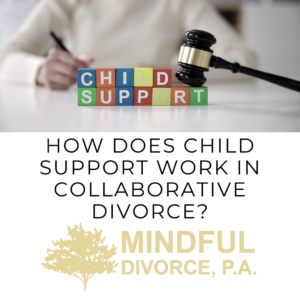 Child Support in Collaborative Divorce: Key Considerations
Child Support in Collaborative Divorce: Key Considerations
In collaborative divorce in Florida, establishing child support is an important step that carries with it many other considerations for your children and for your family.
Here are some key points to understand:
1. Determining Child Support:
In Florida, child support is primarily calculated based on the state’s child support guidelines, which consider factors such as the net monthly income for you and for your spouse, how many children you have together, the healthcare costs for your children, and other relevant factors.
Perhaps, the most important factor that is considered when determining child support is the overnight schedule that you and your spouse will have with your children after the divorce.
This will be called your Parenting Plan, which is required in Florida for any divorce which involves minor children.
2. Customized Parenting Plan:
Unlike traditional divorce proceedings, where a judge makes the decisions for your family on how you will share overnights with your children, Collaborative Divorce provides a defined process for both you and your spouse to work with a child specialist, and to tailor an overnight schedule that specifically meets the needs and circumstances of your children and your family.
This includes considerations such as both you and your spouse enjoying quality time with your children, making sure that each of you has time with your children that is not dedicated to school or work or other obligations. Additionally, your custom parenting plan will consider educational options and decisions for your children, extracurricular activities, holiday time-sharing, and any special needs that your children may have.
By working with a professional team, you and your spouse will create a personalized agreement that puts your children and your family in the best position possible to succeed post-divorce.
In many Collaborative Divorce matters that I work on, the parenting plan is the most important step that we help the family to take. This is an area where the Collaborative Divorce process shines, and where both parents appreciate the value of having a professional team to help them, and the peace of mind to know that they will decide how their family moves forward after the divorce.
3. Focus on the Child’s Best Interests: 50/50 Time-Sharing
Central to Collaborative Divorce is the principle of prioritizing the best interests of your children. Rather than engaging in contentious legal battles, you and your spouse will commit to finding solutions that promote the well-being and stability of your children. This collaborative approach fosters healthier co-parenting relationships and reduces the emotional toll on you and your children.
While I know very well that you and your spouse likely do not agree on many issues, deciding that you will put your children first is likely an area where you and your spouse do agree.
The law in Florida tells me, and the professionals that you will work with, that there is a strong presumption that you and your spouse will each enjoy equal time-sharing with your children. 50/50.
However, the law does not tell you how you are supposed to accomplish a 50/50 schedule that is best for your children.
This is where you will want to spend the most time and energy. You have to get this one right. I can tell you from experience, the Court will likely not get it right. The judge doesn’t know you, your spouse, or your children. Don’t put your parenting plan in the hands of the Court. Do the work to create a custom parenting plan that will put your children’s best interests first. If possible, hire professionals to help you.
4. Financial Transparency:
In collaborative divorce, your professional team will do the work to assure that all of the relevant information is gathered for you by a financial professional. This individual is a trained CPA, and he or she is trained in the Collaborative Divorce process. You will be provided with transparent financial statements throughout your Collaborative Divorce to assure that you know the numbers, and that you are in the best position possible to make good and fair decisions based upon those numbers.
This transparency helps build trust and facilitates constructive negotiations regarding child support and all other important financial decisions to be made in your divorce. This assures that your team helps you to reach a fair and equitable agreement on all issues in your divorce, including child support.
5. Professional Support:
Collaborative Divorce provides you with a team of professionals, including collaboratively trained attorneys, financial advisors, and mental health professionals. Your team will help facilitate discussions, manage conflicts, and ensure that all aspects of child support and a Parenting Plan and distribution of assets and debts are thoroughly addressed. The expertise of your team is invaluable to help you know what you don’t know, and to help you reach a fair agreement.
6. Reduced Conflict & Reduced Cost:
By choosing collaborative divorce, you will minimize conflict and you will avoid the hostility and cost associated with traditional litigation. This can have significant benefits for you and your children, as they are shielded from the stress and trauma of contentious court battles. Instead, you will focus on constructive communication and problem solving.
Your team understands that there will be conflict, and that you and your spouse disagree often, that is why you are getting divorced. However, you both retain your common sense and ability to make good decisions. Your team will help you to build options and provide you with the information that you need to make informed decisions that are best for your family. You will ultimately create a much better co-parenting relationship in the Collaborative Process.
7. Flexibility and Control:
Collaborative divorce empowers you to have greater control over the outcome, including your child support arrangements. Rather than adhering strictly to court-mandated guidelines, you can review all relevant information and agree to a solution that meets the needs of your children and your family. This flexibility allows for a better and more customized agreement.
8. Faster Resolution:
Collaborative Divorce will provide you with a much faster resolution compared to traditional litigation. By avoiding lengthy court proceedings and focusing on productive negotiations, you and your team will be more efficient, saving time and resources in the process. This can be particularly beneficial for your children, as it reduces the prolonged uncertainty and upheaval associated with divorce.
9. Preservation of Relationships In Your Family:
Collaborative Divorce encourages respectful communication and compromise. This serves to help preserve relationships and minimize the negative impact of divorce on your children. By working together to find mutually acceptable solutions, you and your spouse will demonstrate your commitment to co-parenting effectively, laying the foundation for a healthy post-divorce life for your children.
Conclusion
By prioritizing the best interests of your children and fostering open communication and cooperation, you can navigate the complexities of your divorce with greater empathy and understanding. With the support of skilled professionals and a commitment to collaboration, your family will emerge from the divorce process intact. As compared to traditional litigation and its affects on your family, Collaborative Divorce will put your family in a position to be stronger, more resilient, and better equipped to face the future together.
MINDFUL DIVORCE, P.A.
I hope that this information answers some of your questions about divorce, and options that you have, before resorting to an unnecessary legal battle.
If you, or a friend of yours, has questions about Collaborative Divorce in Palm Beach County, we are here to help.




